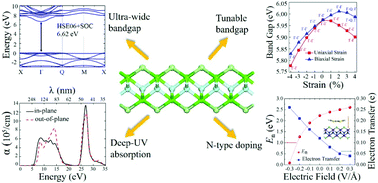Two-dimensional CaFCl: ultra-wide bandgap, strong interlayer quantum confinement, and n-type doping†
Abstract
Two-dimensional (2D) ultra-wide bandgap (UWBG) semiconductors have attracted tremendous attention because of their unique electronic properties and promising applications. Using first-principles calculations, monolayer (bilayer) CaFCl has a cleavage energy of 0.93 J m−2 (0.72 J m−2), suggesting that the exfoliation of monolayer and few-layer materials from the bulk phase could be feasible. The CaFCl monolayer is an UWBG semiconductor with a direct bandgap of 6.62 eV. In addition to the dynamic and thermodynamic stability, it can remain thermally stable at 2200 K, suitable for operation in high-temperature environments. The bandgap of monolayer CaFCl can be tuned by external strain and layer thickness. The decrease of the layer thickness leads to not only a bandgap increase but also an indirect-to-direct bandgap transition, suggesting a strong interlayer quantum confinement effect. Under biaxial strain, the direct bandgap can also be turned into an indirect one. The adsorption of a tetrathiafulvalene (TTF) molecule introduces deep donor states in the gap of CaFCl. Under an external electric field with direction from CaFCl to TTF, the TTF-derived donor states move closer to the conduction band edge of CaFCl and then the adsorption complex becomes effectively n-doped. Furthermore, monolayer CaFCl exhibits pronounced optical absorption in the ultraviolet range of the solar spectrum. These results render CaFCl an attractive 2D material for applications in flexible nanoelectronic and optoelectronic devices.



 Please wait while we load your content...
Please wait while we load your content...